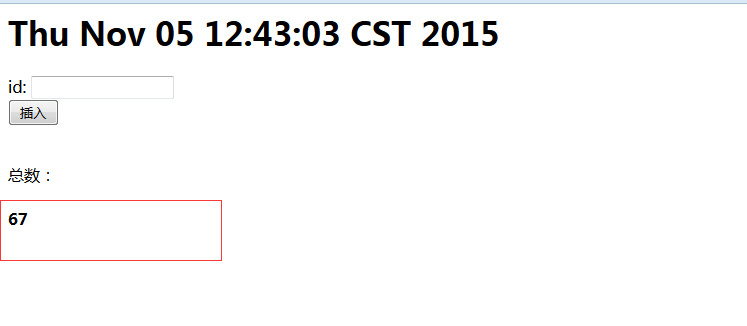2.spring整合ehcache 注解实现查询缓存,并实现实时缓存更新或删除
转自:http://www.importnew.com/23358.html
写在前面:上一篇博客写了spring cache和ehcache的基本介绍,个人建议先把这些最基本的知识了解了才能对今天主题有所感触。不多说了,开干!
注:引入jar
<!-- 引入ehcache缓存 -->
<dependency>
<groupId>net.sf.ehcache</groupId>
<artifactId>ehcache</artifactId>
<version>2.8.3</version>
</dependency>
第一步:首先配置ehcache.xml

<?xml version="1.0" encoding="UTF-8"?>
<ehcache xmlns:xsi="http://www.w3.org/2001/XMLSchema-instance"
xsi:noNamespaceSchemaLocation="ehcache.xsd"
updateCheck="true" monitoring="autodetect"
dynamicConfig="true"> <diskStore path="java.io.tmpdir"/>
<defaultCache
maxEntriesLocalHeap="10000"
eternal="false"
overflowToDisk="false"
timeToIdleSeconds="120"
timeToLiveSeconds="120"
diskSpoolBufferSizeMB="30"
maxEntriesLocalDisk="10000000"
diskExpiryThreadIntervalSeconds="120"
memoryStoreEvictionPolicy="LRU">
<persistence strategy="localTempSwap"/>
</defaultCache> <cache name="myCache"
maxEntriesLocalHeap="10000"
maxEntriesLocalDisk="1000"
eternal="false"
diskSpoolBufferSizeMB="30"
timeToIdleSeconds="300"
timeToLiveSeconds="600"
memoryStoreEvictionPolicy="LFU"
transactionalMode="off">
<persistence strategy="localTempSwap"/>
</cache>
</ehcache>

第二步:在spring.xml的配置文件中引入schema,
xmlns:aop="http://www.springframework.org/schema/aop"和http://www.springframework.org/schema/cache http://www.springframework.org/schema/cache/spring-cache-3.2.xsd
缓存的配置:

<!-- 启用缓存注解功能,这个是必须的,否则注解不会生效,另外,该注解一定要声明在spring主配置文件中才会生效 -->
<cache:annotation-driven cache-manager="ehcacheManager"/> <!-- cacheManager工厂类,指定ehcache.xml的位置 -->
<bean id="ehcacheManagerFactory" class="org.springframework.cache.ehcache.EhCacheManagerFactoryBean">
<property name="configLocation" value="classpath:ehcache.xml" />
</bean>
<!-- 声明cacheManager -->
<bean id="ehcacheManager" class="org.springframework.cache.ehcache.EhCacheCacheManager">
<property name="cacheManager" ref="ehcacheManagerFactory" />
</bean>

OK!缓存的相关配置已经完成。下面开始编写测试程序。这里需要连接数据库,我就不写了。这里为了方便就随便找了之前写过的model,这个model就是AOP注解实现日志管理的实体,为了偷懒就直接用了,希望你们不要误解,没有特殊意义的
第三步:编写model,这里需要注意,要实现缓存的实体必须要序列化 private static final long serialVersionUID = -6579533328390250520L; 关于序列化的生成这里就不介绍了,大家可以百度看看。
package org.shop.entity; import java.io.Serializable;
import java.util.Date; public class SystemLog implements Serializable { private static final long serialVersionUID = -6579533328390250520L; private String id; private String description; private String method; private Long logType; private String requestIp; private String exceptioncode; private String exceptionDetail; private String params; private String createBy; private Date createDate; public String getId() {
return id;
} public void setId(String id) {
this.id = id == null ? null : id.trim();
} public String getDescription() {
return description;
} public void setDescription(String description) {
this.description = description == null ? null : description.trim();
} public String getMethod() {
return method;
} public void setMethod(String method) {
this.method = method == null ? null : method.trim();
} public Long getLogType() {
return logType;
} public void setLogType(Long logType) {
this.logType = logType;
} public String getRequestIp() {
return requestIp;
} public void setRequestIp(String requestIp) {
this.requestIp = requestIp == null ? null : requestIp.trim();
} public String getExceptioncode() {
return exceptioncode;
} public void setExceptioncode(String exceptioncode) {
this.exceptioncode = exceptioncode == null ? null : exceptioncode.trim();
} public String getExceptionDetail() {
return exceptionDetail;
} public void setExceptionDetail(String exceptionDetail) {
this.exceptionDetail = exceptionDetail == null ? null : exceptionDetail.trim();
} public String getParams() {
return params;
} public void setParams(String params) {
this.params = params == null ? null : params.trim();
} public String getCreateBy() {
return createBy;
} public void setCreateBy(String createBy) {
this.createBy = createBy == null ? null : createBy.trim();
} public Date getCreateDate() {
return createDate;
} public void setCreateDate(Date createDate) {
this.createDate = createDate;
}
}
第四步:编写dao,service
package org.shop.dao;
import org.shop.entity.SystemLog;
public interface SystemLogMapper {
int deleteByPrimaryKey(String id);
int insert(SystemLog record);
int insertSelective(SystemLog record);
SystemLog selectByPrimaryKey(String id);
int updateByPrimaryKeySelective(SystemLog record);
int updateByPrimaryKey(SystemLog record);
int count();
}
public interface SystemLogService {
int deleteSystemLog(String id);
int insert(SystemLog record);
int insertTest(SystemLog record);
SystemLog findSystemLog(String id);
int updateSystemLog(SystemLog record);
int count();
}
第五步:编写serviceImpl并添加缓存注解。这里缓存注解的参数不介绍了,不懂得看我上一篇博客,我这里先把需要的注解都写上了,一会一个一个介绍。

@Service("systemLogService")
public class SystemLogServiceImpl implements SystemLogService {
@Resource
private SystemLogMapper systemLogMapper;
@Override
public int deleteSystemLog(String id) {
return systemLogMapper.deleteByPrimaryKey(id);
}
@Override
//@CachePut(value="myCache")
//@CacheEvict(value="myCache",allEntries=true,beforeInvocation=true)
@CacheEvict(value="myCache",key="0",beforeInvocation=true)
public int insert(SystemLog record) {
return systemLogMapper.insertSelective(record);
}
@Override
@Cacheable(value="myCache",key="#id")
public SystemLog findSystemLog(String id) {
return systemLogMapper.selectByPrimaryKey(id);
}
@Override
public int updateSystemLog(SystemLog record) {
return systemLogMapper.updateByPrimaryKeySelective(record);
}
@Override
public int insertTest(SystemLog record) {
return systemLogMapper.insert(record);
}
@Override
@Cacheable(value="myCache",key="0")
public int count() {
int num = systemLogMapper.count();
return num;
}
}

第六步:编写controller,即我们的测试。

@Controller
@RequestMapping("systemLogController")
public class SystemLogController { @Resource
private SystemLogService systemLogService; @RequestMapping("testLog")
public ModelAndView testLog(){
ModelMap modelMap = new ModelMap();
SystemLog systemLog = systemLogService.findSystemLog("c30e2398-079a-406b-a2f7-a85fa15ccac7");
modelMap.addAttribute("data", systemLog);
return new ModelAndView("index",modelMap);
}
@RequestMapping("insert")
@ResponseBody
public boolean Insert(SystemLog record){
systemLogService.insert(record);
return true;
} @RequestMapping("test1")
public ModelAndView test1(){
ModelMap modelMap = new ModelMap();
int num =systemLogService.count();
modelMap.addAttribute("num", num);
return new ModelAndView("pageEhcache",modelMap);
} }

我们先测试查询的缓存,即serviceImpl中的 findSystemLog(String id) 方法,我们访问testLog.do,第一次运行如下图,注意控制台中的heap和 disk

再一次访问testLog.do,运行你会发现没有访问数据库,如图:

到此查询的缓存我们实现了,但是关于缓存的处理我们并没有做完,我们应该在深入思考下,在上面查询的缓存生命周期内,我们对刚才查询的表进行了增删改操作,这时我们再访问该查询方法,你会发现我们的数据并没有改变,还是增删改操作之前的数据(因为缓存的生命还在),这里是不是问题呢?此时我们需要对查询的缓存进行更新或删除。
下面我们看serviceImpl中的insert方法和count()方法,count的方法是统计表中的数据总记录,insert方法是对该表进行新增一条记录,insert的缓存注解用的是@CacheEvict(value="myCache",key="0",beforeInvocation=true),这里清除的是指定缓存,也就是count方法中@Cacheable(value="myCache",key="0")的,(serviceImpl中注释的@CacheEvict(value="myCache",allEntries=true,beforeInvocation=true)是清除所有的缓存,这里我就不演示了,道理是一样的)
这里我提供一个测试pageEhcache.jsp页面,

<%@ page language="java" import="java.util.*" pageEncoding="UTF-8"%>
<%
String path = request.getContextPath();
String basePath = request.getScheme()+"://"+request.getServerName()+":"+request.getServerPort()+path+"/";
%>
<!DOCTYPE HTML PUBLIC "-//W3C//DTD HTML 4.01 Transitional//EN">
<html>
<head>
<title>测试</title>
<script type="text/javascript" src="<%=request.getContextPath()%>/js/jquery-1.11.1.min.js"></script>
<script type="text/javascript">
function insert(){
var record = $("#formID").serializeArray();
console.info(record);
$.ajax({
url : "<%=request.getContextPath()%>/systemLogController/insert.do",
type : 'post',
async:true,
dataType:'json',
data : record,
success:function(result){
alert("插入成功!");
}
});
}
</script>
</head>
<body>
<h1><%=new Date()%></h1>
<h1>这是一个练习</h1>
<form id="formID" action="">
id: <input name="id" type="text"/><br>
<input type="button" value="插入" onclick="insert()"/>
</form>
<br>
总数:
<h4>${num}</h4>
</body>
</html>

我们先访问test1.do,看下表中的记录数并注意控制台变化
页面显示如下,注意总数是67,

再一次访问test1.do,没有访问数据库,说明count()方法的缓存生效了,

接下来开始新增记录,点击插入按钮

注意控制台显示,这里执行了inserSQL语句,并remove了count()方法上的缓存,

接下来再次访问test1.do,我们看到总数变化了,增加了一条,说明我们把之前count()方法上的缓存删除了,又执行了查询总数的sql


再次访问test1.do,count()方法的缓存生效了,对吧!这个就是@CacheEvict注解的作用。

在insert()方法上还有@CachePut(value="myCache")注解,上面的serviceImpl中注释了,它的作用是:@CachePut标注的方法在执行前不会去检查缓存中是否存在之前执行过的结果,而是每次都会执行该方法,并将执行结果以键值对的形式存入指定的缓存中。
我这里就不做演示了,你们可以自己动手试试。
总结:我个人的理解,对查询方法增加缓存容易,但对于缓存的更新的处理就比较麻烦,我上面的serviceImpl中写了三种处理方式,
1.用@CachePut处理,这中方法需要对指定缓存key保持一致,尽管这样,还是不行,因为它返回的缓存是int(增加或删除或修改的记录数或是该记录的对象,这对我们查询所有或部分记录的缓存还是不可行的)
2.用@CacheEvict(value="myCache",key="0",beforeInvocation=true)处理,清除我们指定key的缓存,这种方式缺点是麻烦,需要我们注意每一个缓存的key
3.用@CacheEvict(value="myCache",allEntries=true,beforeInvocation=true)处理,清除所有缓存,这种方式最省事,但会把其他缓存也一同清除。
随着业务的复杂性的不断增加,这些处理方式,可能会增加代码的复杂性,然后我想到的是对DB层进行缓存,可以利用redis,mamchched的进行处理。当然对于一般的web应用运用ehcache已经刻一解决了,但是对大数据量的运用db级别的缓存效果性能可能会更好。
以上纯粹是个人想法。另外我也想了想缓存到底在哪些场景下应用会比较好,不知道你们是怎么认为的。也请大家给点建议。
2.spring整合ehcache 注解实现查询缓存,并实现实时缓存更新或删除的更多相关文章
- spring整合ehcache注解实现查询缓存,并实现实时缓存更新或删除
转载: http://www.importnew.com/23358.html 写在前面:上一篇博客写了spring cache和ehcache的基本介绍,个人建议先把这些最基本的知识了解了才能对今天 ...
- spring整合ehcache 注解实现查询缓存,并实现实时缓存更新或删除
写在前面:上一篇博客写了spring cache和ehcache的基本介绍,个人建议先把这些最基本的知识了解了才能对今天主题有所感触.不多说了,开干! 注:引入jar <!-- 引入ehcach ...
- Spring整合Ehcache管理缓存
前言 Ehcache 是一个成熟的缓存框架,你可以直接使用它来管理你的缓存. Spring 提供了对缓存功能的抽象:即允许绑定不同的缓存解决方案(如Ehcache),但本身不直接提供缓存功能的实现.它 ...
- Spring整合Ehcache管理缓存(转)
目录 前言 概述 安装 Ehcache的使用 HelloWorld范例 Ehcache基本操作 创建CacheManager 添加缓存 删除缓存 实现基本缓存操作 缓存配置 xml方式 API方式 S ...
- 以Spring整合EhCache为例从根本上了解Spring缓存这件事(转)
前两节"Spring缓存抽象"和"基于注解驱动的缓存"是为了更加清晰的了解Spring缓存机制,整合任何一个缓存实现或者叫缓存供应商都应该了解并清楚前两节,如果 ...
- Spring整合EHCache框架
在Spring中使用缓存可以有效地避免不断地获取相同数据,重复地访问数据库,导致程序性能恶化. 在Spring中已经定义了缓存的CacheManager和Cache接口,只需要实例化便可使用. Spr ...
- Spring整合EhCache详解
一.EhCache介绍 EhCache 是一个纯Java的进程内缓存框架,具有快速.精干等特点,是Hibernate中默认的CacheProvider.Ehcache是一种广泛使用的开 源Java分布 ...
- spring 整合hibernate注解时候,出现“Unknown entity: com.ssh.entry.Admin; nested exception is org.hibernate.MappingException: Unknown entity: com.ssh.entry.Admin”异常的问题
今天学习使用ssh框架的时候,出现一个异常,弄了好久才找到,在这记录一下,我的sb错误1.spring整合hibernate,取代*.hbm.xml配置文件 在applicationContext ...
- Hibernate Validation与Spring整合各注解的用法Demo
转自:https://www.aliyun.com/jiaocheng/1315650.html <dependency> <groupId>org.hibernate< ...
随机推荐
- HDU1598 并查集+贪心
find the most comfortable road Time Limit: 1000/1000 MS (Java/Others) Memory Limit: 32768/32768 K ...
- Presto改造
最近在打造一款可视化分析产品, 需要用到组合多数据源, 进行查询, 看了挺多开源的插件, 发现目前只有Presto比较符合, 但是由于Presto没有多用户机制和资源管理, 所以需要在这基本上构建多用 ...
- vue-router与v-if实现tab切换的思考
vue-router 该如何使用 忽然碰到一个常见的问题,明明可以使用 v-if / v-show 可以的解决的问题,有没有必要是使用 vue-router来解决. 比如常见的 tab 切换.一时间, ...
- Java 调用PHP的Web Service(三)
usoap是PHP环境中的开源soap工具,算是用得比较多的一个工具了. 在utf-8环境中,nusoap可以工作得很好.但是当用于中文环境中时,nusoap经常会出现一些让人不得其解的问题. 最近一 ...
- asp.net(c#)开发中的文件上传组件uploadify的使用方法(带进度条)
上文件传很常见,现在就文件上传利用HTML的File控件(uploadify)的,这里为大家介绍一下(uploadify)的一些使用方法.在目前Web开发中用的比较多的,可能uploadify(参考h ...
- bzoj2325
题解: 树链剖分 和普通的树链剖分不一样,这里的线段树不只是要记录x-y的和 而是要记录x左到y左,x左到y右,x右到y左,x右到y右 然后就可以了 代码: #include<bits/stdc ...
- Android 五种存储方式个人总结
一 . 文件存储 FileOutputStream out = openFileOutput("data",Context.MODE_PRIVATE); BufferedWrite ...
- 再谈Spring AOP
1.AOP的基本概念 在进行AOP开发前,先熟悉几个概念: 连接点(Jointpoint):表示需要在程序中插入横切关注点的扩展点,连接点可能是类初始化.方法执行.方法调用.字段调用或处理异常等等,S ...
- python中多进程
多进程 什么是进程 进程:正在进行的一个过程或者说一个任务,而负责执行任务的是CPU. 进程和程序的区别 程序仅仅是一堆代码而已,而进程指的是程序的运行过程. 举例 想象以为有着一手好厨艺的科学家肖亚 ...
- Nginx 设置rewrite规则是遇到的一个{}大括号引发的报错问题
一个群友提到: 用nginx image_filter模块裁图,用!拼宽高能够实现,现在想用参数传宽高总是报错,配置如下: location ~ ^/images/.* { if ( $q ...
